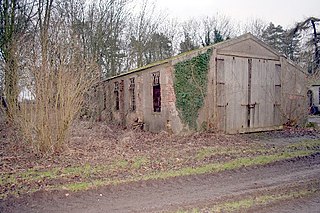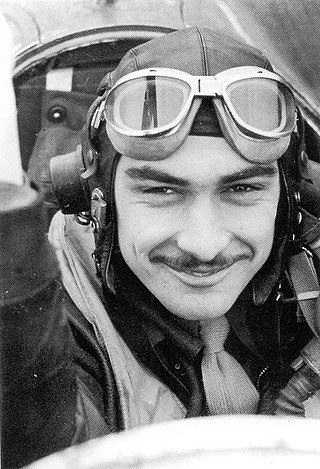Related Research Articles

Royal Air Force Kenley, more commonly known as RAF Kenley is a former airfield station of the Royal Flying Corps in the First World War and the RAF in the Second World War. It played a significant role during the Battle of Britain as one of the three RAF stations specifically tasked with the defence of London. It is located near Kenley on the edge of Greater London. The site remains in use with the Ministry of Defence, as Kenley Airfield.

John Gillespie Magee Jr. was a World War II Anglo-American Royal Canadian Air Force fighter pilot and war poet, who wrote the sonnet "High Flight". He was killed in an accidental mid-air collision over England in 1941.

The Battle of Britain Memorial Flight (BBMF) is a Royal Air Force flight which provides an aerial display group usually comprising an Avro Lancaster, a Supermarine Spitfire and a Hawker Hurricane. The aircraft are regularly seen at events commemorating the Second World War and upon British State occasions, notably Trooping the Colour, celebrating Queen Elizabeth II's 80th birthday in 2006, as well as the wedding of Prince William and Catherine Middleton in 2011 and at air displays throughout the United Kingdom and Europe.

James Francis Edwards, CM, DFC & Bar, DFM, CD, later known as Stocky Edwards, was a Canadian fighter pilot during World War II. With 19 confirmed aerial victories, Edwards was Canada's highest scoring ace in the Western Desert Campaign.
Irving Farmer 'Hap' Kennedy was a Canadian fighter pilot in the Royal Canadian Air Force (RCAF) during the Second World War. He was one of Canada's highest-scoring aces of the war, with 10 solo and 5 shared aircraft destroyed, and 1 probably destroyed.
Lieutenant-General Donald Currie Laubman, was a Second World War Canadian fighter pilot and flying ace. He remained in the Canadian armed services after the war rising to the rank of Lieutenant-General.

Redhill Aerodrome is an operational general aviation aerodrome located 1.5 NM south-east of Redhill, Surrey, England, in green belt land.

Lloyd Vernon "Chad" Chadburn DSO & Bar, DFC was a Canadian World War II fighter pilot.

Flight Lieutenant James Henry Whalen was a Canadian Second World War fighter pilot ace.

426 Transport Training Squadron is a unit of the Canadian Forces under Royal Canadian Air Force, located at CFB Trenton in Trenton, Ontario. It originated as a squadron in the Royal Canadian Air Force (RCAF) that fought during the Second World War as a bomber squadron.

The Supermarine Spitfire, the only British fighter to be manufactured before, during and after the Second World War, was designed as a short-range fighter capable of defending Britain from bomber attack and achieved legendary status fulfilling this role during the Battle of Britain. According to fighter ace J.E. "Johnnie" Johnson it was the best conventional defensive fighter of the war.

Adolf "Addi" Glunz was a German Luftwaffe military aviator and fighter ace during World War II. He is credited with 71 aerial victories achieved in 574 combat missions. All but three of his victories were claimed over the Western Front and in Defense of the Reich. This figure included seventeen four-engine bombers and 37 Supermarine Spitfire fighters.

No. 412 Transport Squadron is one of three Royal Canadian Air Force (RCAF) transport squadrons attached to Ottawa, Ontario. The squadron operates with a strength of about 29 out of the Pilot Officer John Gillespie Magee, Jr. Annex.The Annex officially opened on January 11, 1995.

No. 401 Tactical Fighter Squadron, a.k.a. "City of Westmount" Squadron, is a Royal Canadian Air Force squadron based at CFB Cold Lake. During World War II it was a fighter squadron and is notable for having fought in the Battle of Britain. Postwar, the squadron operated in Canada as an auxiliary squadron, reserve squadron and a helicopter and training squadron. In 2015 it was reactivated as a tactical fighter squadron.

Royal Air Force Wellingore or more simply RAF Wellingore is a former Royal Air Force fighter relief landing ground located 1.9 miles (3.1 km) south of Navenby, Lincolnshire and 10 miles (16 km) south of Lincoln, Lincolnshire, England.

No. 485 (NZ) Squadron was a fighter squadron established for service during the Second World War. It was the first New Zealand squadron formed under Article XV of the Empire Air Training Plan. Although many of its flying personnel were largely drawn from the Royal New Zealand Air Force, the squadron served in Europe under the operational and administrative command of the Royal Air Force.

James Alexander Goodson was a United States Army Air Force fighter ace who was credited with shooting down fifteen aircraft and destroying another fifteen on the ground during World War II.

Squadron Leader Johannes Jacobus "Chris" le Roux, was a South African flying ace of the Second World War, who flew for the Royal Air Force (RAF). He is credited with 23.5 kills
Roderick Illingworth Alpine Smith, was a flying ace who served in the Royal Canadian Air Force (RCAF) during the Second World War. He was credited with having shot down at least fourteen aircraft.
References
- ↑ "Spitfire pilot credited with wounding General Rommel - The Independent". London. November 18, 2008. Archived from the original on November 21, 2010. Retrieved November 18, 2008.
- ↑ Marco Mattioli, ”Chris” Le Roux, l'uomo che attaccò Rommel, in Aerei nella Storia, nº 76, Parma, West-Ward Edizioni, febbraio-marzo 2011, pp. 12-15, ISSN 1591-1071 (WC · ACNP).
- ↑ « funeral oration », by Pierre Clostermann.
- ↑ Véronique Chemla, « Jacques Remlinger (1923-2002), pilote chasse de la RAF et des FAFL », 18 juin 2015.
- ↑ Rumleski, Kathy (October 19, 2008). "Gutsy flyer dies in car crash". London Free Press. Retrieved October 19, 2008.[ dead link ]